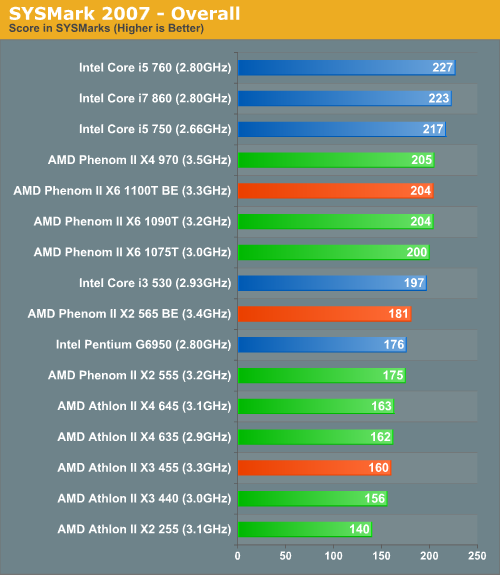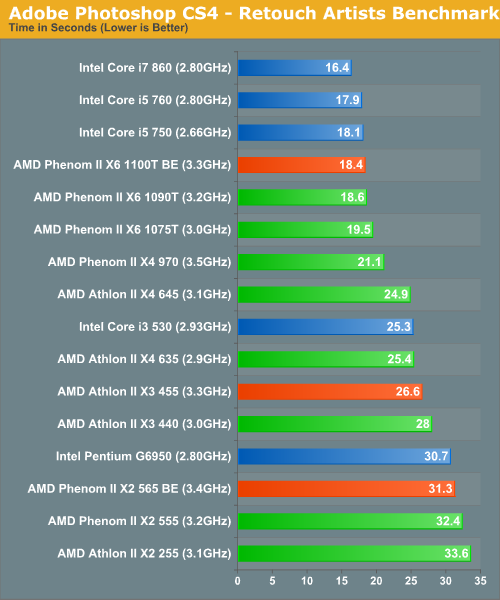AMD's Winter Update: Athlon II X3 455, Phenom II X2 565 and Phenom II X6 1100T
by Anand Lal Shimpi on December 7, 2010 12:01 AM EST- Posted in
- CPUs
- AMD
- Phenom II X6
- Athlon II
- Phenom II
SYSMark 2007 Performance
Our journey starts with SYSMark 2007, the only all-encompassing performance suite in our review today. The idea here is simple: one benchmark to indicate the overall performance of your machine.

SYSMark 2007 is getting very long in the tooth and we're still another couple of quarters away from an updated version for 2011. That being said, it does function as a good representation of lightly threaded application performance. There's little to gain from moving to four cores here and basically nothing to be seen from the move to six cores. The Phenom II X6 1100T is within several percent of the performance of its Core i5/i7 competitors.
The lack of an L3 cache holds the Athlon II back, which is made evident by the solid performance increase seen by the 565 BE. Both of these parts are around 10% off of their competitive performance targets.
Adobe Photoshop CS4 Performance
To measure performance under Photoshop CS4 we turn to the Retouch Artists’ Speed Test. The test does basic photo editing; there are a couple of color space conversions, many layer creations, color curve adjustment, image and canvas size adjustment, unsharp mask, and finally a gaussian blur performed on the entire image.
The whole process is timed and thanks to the use of Intel's X25-M SSD as our test bed hard drive, performance is far more predictable than back when we used to test on mechanical disks.
Time is reported in seconds and the lower numbers mean better performance. The test is multithreaded and can hit all four cores in a quad-core machine.

In our Photoshop CS4 test, AMD has effectively equalled the performance of the Core i5 with the Phenom II X6 1100T. The i7 860 is a bit faster but the i5 comparison is very close. The Athlon II X3 455 is 15% faster than its closest competitor, the Pentium G6950. The Phenom II X2 565 BE doesn't get many points for its large cache, it's the third core that puts the Athlon II X3 ahead here.










65 Comments
View All Comments
Aone - Tuesday, December 7, 2010 - link
Unfortunately, the auther didn't explain the big and strange difference between the idle power figures of Athlons and Phenoms.For instance:
Athlon II X3 455 (3.3GHz) - 63.9W,
Athlon II X3 440 (3.0GHz) - 80.3W!
Phenom II X4 970 (3.5GHz) - 66.9,
Athlon II X4 645 (3.1GHz) - 75W!
Athlon II X4 635 (2.9GHz) - 79.5W!
shooty - Tuesday, December 7, 2010 - link
I am also interested in this difference... specifically the x2 555 vs the x2 565.Almost a 20W difference in idle and a 40W difference at load!
What is going on to give this huge difference for (just) a clock bump?
Anand, can you please post tested voltages of these cpus? I know from my experience that some motherboards put them at a higher stated voltage (above 1.4v).
BTW, I'm 2 for 2 in getting the two extra cores to be stable on the 555.
Marlin1975 - Tuesday, December 7, 2010 - link
not only that but the lowwer Ghz chip was beating the higher Ghz chip in games.Maybe there is more than just a speed bump?
Anand Lal Shimpi - Tuesday, December 7, 2010 - link
As I mentioned in the test page our older Athlon II/Phenom II numbers were run on a 7-series board vs. the new 890GX board we switched to in the last review. I've pulled the conflicting numbers to avoid confusion :)Take care,
Anand
semo - Tuesday, December 7, 2010 - link
I'm pretty sure the X2 chip offers directed I/O and possibly better vm performance than the X3. It would be interesting to find out.Also I don't like it when the front page introduction differs from the main article's. I think you should keep it consistent across all front page articles (news or reviews).
StevoLincolnite - Tuesday, December 7, 2010 - link
I have a Phenom 2 x6 1090T.Now I'm wondering why you didn't push more voltage through that chip? It can handle 1.45volts with a decent cooler easily enough which would have pushed you over that 4ghz mark.
I'm also surprised at the large performance difference the 100mhz increase in clockspeed provided in the benchmarks between the 1090T and the 1100T!
108fps for the 1090T and 120fps for the 1100T.
That's what... 10-12% improvement for just 100mhz? Doesn't seem to add-up in my eyes.
Finally - Tuesday, December 7, 2010 - link
Just because your chip can handle 1.45V, doesn't mean that any chip can.nitrousoxide - Tuesday, December 7, 2010 - link
Thubans can reach 4.0GHz at 1.4V, that's true for almost all the Thuban parts.MrSpadge - Tuesday, December 7, 2010 - link
The board has changed. Such things matter in games.MrS
chester457 - Tuesday, December 7, 2010 - link
I use 7zip everyday and find your 7zip benchmark a little misleading. I'd prefer if you just did a bench with only 2 cores enabled. PAR2 already tests 3+ core archiving. By using 7zip you're invoking real-world performance because 7zip is a program many people use daily. It'd be nice to have the 2 core (real-world) performance instead of a theoretical one no user can ever hit.